flute
All scores that include a part for at least one flute.
Lane - Seven Rants - Wind Quintet & Piano
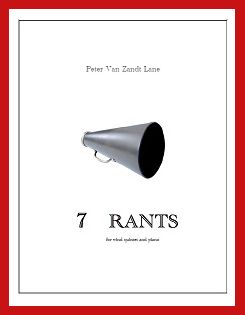 Seven Rants, by Peter Van Zandt Lane
Seven Rants, by Peter Van Zandt Lane
Contemporary Composition for Flute, Oboe, Clarinet, Horn, Bassoon, and Piano, PDF $0.00
Peter Van Zandt Lane was commissioned to compose this piece for the 67th Composers Conference and Chamber Music Workshop at Wellesley College, which took place in the summer of 2011. The annual Conference is a wonderful two-week event, which brings together prominent young composers, superb professional musicians, dedicated amateur chamber musicians, and enthusiastic listeners. The professional musicians premiere the composers' new works and also coach the amateur musicians in chamber ensembles. Concerts are free and open to the public. For more information on the program, please visit the Composers Conference website.
After the Conference each year, one of the composer fellows is selected to create a new work for the next year's chamber music workshop participants. That composer returns the following summer to coach two groups of players on the new composition, in preparation for performances in the Saturday evening concerts of Week I and Week II. Peter Van Zandt Lane's Seven Rants was an enormous success in 2011, absolutely loved by the players and received exceptionally well by the audience. Written for flute, oboe, clarinet, horn, bassoon, and piano, Seven Rants is a series of seven delightful and diverse movements. The first and last movements are strict palindromes. The five middle movements or "rants" are "mini-concertos", each highlighting a different wind instrument. Great fun to play, and highly accessible.
With permission from both the composer and the Wellesley Composers Conference and Chamber Music Center, Noteworthy Sheet Music is thrilled to offer our customers a free PDF download of Seven Rants by Peter Van Zandt Lane. And please check out more of this terrific young composer's work, including two other listings in the NSM catalog, Danzas Mecánicas and Transverse Fractures.
Score, 37 pages: Flute part, 10 pages; Oboe part, 9 pages; Clarinet part, 10 pages; Horn part, 9 pages; Bassoon part, 9 pages; Piano part, 15 pages; Total, 103 pages.
Lane - Transverse Fractures - Flute & Piano
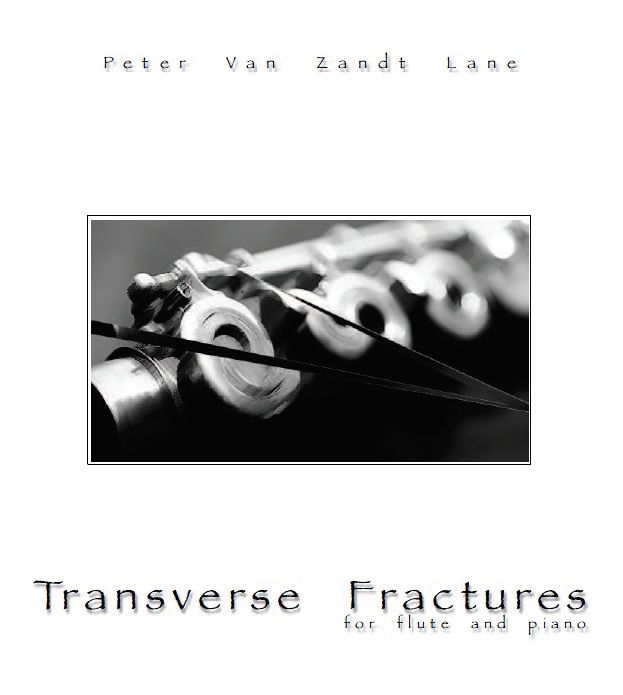 Transverse Fractures, by Peter Van Zandt Lane
Transverse Fractures, by Peter Van Zandt Lane
Contemporary Composition for Flute and Piano, PDF $20.00
Peter Van Zandt Lane's compositions have been featured on various festivals and conferences such as the New York City Electroacoustic Music Festival, Spark Festival, FEASt Fest, SEAMUS National Conferences, Forecast Music, Festival Miami, and LIPM/IEMS at the world renowned Teatro Colón in Buenos Aires. He has received awards in several competitions including the CRS Young Composers competition, the Forecast Music International Composers Competition, The Greater Miami Youth Symphony Composition Competition, and the Cleveland Orchestra Miami Residency Call for Scores. He has been a finalist twice for the ASCAP/SEAMUS Student Commission, and is an active member of the Composers in Red Sneakers, one of the country's longest-running composer consortiums.
Transverse Fractures (2009) is a short, virtuosic, high-energy duet for flute and piano. The piece was derived from a larger, longer chamber work entitled Partial Fractures, which the composer wrote for NotaRiotous Ensemble. Transverse Fractures, approximately 5 minutes long, is a piece of considerable difficulty for both the flutist and the pianist.
Piano Score, 13 pages; Flute Part, 7 pages; Total, 23 pages.
PreviewLi Qi - Fog - Flute Alone
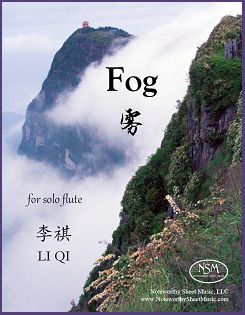 Fog, by Li Qi
Fog, by Li Qi
Contemporary Composition for Solo Flute, PDF $5.99
Fog was written in 2012 by the up-and-coming young composer Li Qi. In addition to receiving other projects and awards, Li Qi was selected by the Wellesley Chamber Music Workshop to compose the program's commissioned piece for 2016, An Autumn Dusk in the Mountains for flute1, flute2/alto flute, cello, and piano.
Short, interesting, and challenging, Fog will appeal to advanced flutists and their audiences. Inspired by the poem "Stray Birds" by Rabindranath Tagore, the piece strives to capture in a musical way the recurring interplay between fog and sunlight, as a representation of the circle of life with all its sorrow, joy, and continuously-unfolding beauty. A recording of a 2012 performance of Fog by Heath White at the Jacobs School of Music, Indiana University, has been posted on YouTube; please click the link to listen.
Our front cover image is from Wikimedia Commons: "The Mount Emei" by pookieevans (CC BY-SA 2.0).
Flute part, 3 pages; Total, 7 pages.
McDonald - Three Four-Note Flute Duets - Two Flutes
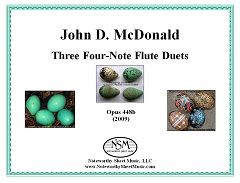 Three Four-Note Flute Duets, Op.448b, by John D. McDonald
Three Four-Note Flute Duets, Op.448b, by John D. McDonald
Contemporary Composition for Two Flutes, PDF $2.99
"Composed for Ethel Farny and her flute students at the Rivers Music School, these short duets sprout initially from the first flute/violin duet of Several Strands, Op. 448a. This Grazioso is indeed made from only four pitches. Similarly, Murmurando confines itself to a four-note knot until its final dyad. The third duet, Con Eleganza, stretches the four-note concept a bit more. Each instrument has its own four-pitch pattern, and a coda leaves the four-note idea behind all together, concluding the set with six slower, somewhat more chromatic bars that could very well lead to future music of more emotional complexity. Perhaps there will be more duets to come." ― John McDonald, November 2009
John McDonald is a member of The Mockingbird Trio, directs the Tufts Composers Concert Series, and serves on the boards of several performance organizations in New England. He has recently fulfilled commissions from The Chamber Orchestra of Boston, pianist David Holzman, The Firebird Ensemble (for an Apple Hill Center for Chamber Music Residency, with support from a Meet the Composer MetLife Creative Connections Award), and the ANA Trio (Fredonia University; soprano, cello, and piano), among others. Recent performances by McDonald at the Goethe Institut of Boston, at Tufts, and at many other venues have been highly acclaimed.
Score for Two Flutes, 2 pages; Total, 4 pages.
McDonald - Three Melodies That Descend - Flute
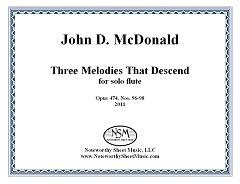 Three Melodies That Descend, Op.474, Nos.96-98 by John D. McDonald
Three Melodies That Descend, Op.474, Nos.96-98 by John D. McDonald
Contemporary Composition for Solo Flute, $2.99
John McDonald is Professor of Music at Tufts University, where he served as Director of Graduate Music Studies from 2000 to 2010 and Department Chair from 2000 to 2003. He was named the 2007 MTNA—Shepherd Distinguished Composer of the Year by the Music Teachers National Association, and received the 2009 Lillian and Joseph Leibner Award for Distinguished Teaching and Advising from Tufts University. In 2010, he received the Waring Prize from Western Reserve Academy, the highest award given to alumni of that school. His recordings appear on the Albany, Archetype, Boston, Bridge, Capstone, Neuma, New Ariel, and New World labels, and he has concertized widely as composer, pianist, and collaborative performer. New releases include pianist Andrew Rangell's performance of McDonald's Meditation Before A Sonata: Dew Cloth, Dream Drapery, on Bridge Records.
McDonald's Three Melodies That Descend, Op.474, Nos.96-98 were written for composer and flutist Joshua Hahn after his graduation from Tufts University in May 2011. They work on the principle that what starts high must come down, and they are also a foil to the Eleven Melodies That Go Up In Different Ways (Op. 474, Nos. 30-40).
Flute part, 2 pages; Total, 4 pages.
Mendelssohn - Concert Piece No.1 - Two Winds and Piano
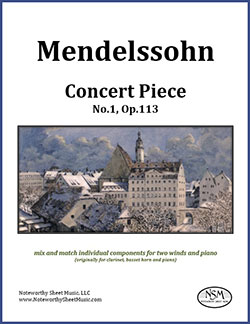 Concert Piece No.1, Op.113, by Felix Mendelssohn
Concert Piece No.1, Op.113, by Felix Mendelssohn
Transcribed for Various Wind Instruments and Piano by John W. Pratt
(originally for Clarinet, Basset Horn, and Piano)
Individual Secondo parts for Bassoon, Clarinet, or English Horn, PDFs $6.99 each
Piano Score, with original Clarinet and Basset Horn lines in concert pitch, PDF $6.99
The following is excerpted from John Pratt's © foreword:
"In 1833, Felix Mendelssohn (1809-1847) wrote two Concert Pieces for Clarinet, Basset Horn, and Piano, op. 113 and op. 114, as show-pieces for the famous clarinetist Heinrich Bärmann (1784-1847) to play with his up-and-coming son Karl (1811-1885) on the basset horn. // Mendelssohn's two Concert Pieces are very suitable for transcription, even aside from the rarity of the basset horn today. We provide, as well as the original clarinet part, transcriptions of it for flute and oboe. Transcriptions of the basset horn part are provided for bassoon, clarinet, and English horn. These primo and secondo parts can be mixed and matched at will. For the score, we use Mendelssohn's instruments rather than some other arbitrary pair. This enables anyone interested to check any transcribed part against the original. The score gives the parts in concert pitch, because a transposition would apply to only one of the possible winds, and because the pianist can then easily play any part at original pitch."
Please note that PDFs of the original score and clarinet-primo part are available free of charge in the public domain (see the listing of this work on IMSLP.org), and our transcribed primo and secondo wind parts can readily be used with the original score. Therefore, you should purchase our original instrument Score or Clarinet-primo part only if you would like measure numbers or Mr. Pratt's score (for piano with clarinet and basset horn) in concert pitch.
- Piano Score with Clarinet and Basset Horn lines in concert pitch, 8 pages; Total, 10 pages (note that the original score is freely available on IMSLP.org)
- Clarinet in B-flat, primo part, 4 pages; Total, 6 pages (note that the original clarinet part is freely available on IMSLP.org)
- Flute, transcribed primo part, 4 pages; Total, 6 pages
- Oboe, transcribed primo part, 4 pages; Total, 6 pages
- Bassoon, transcribed secondo part, 4 pages; Total, 6 pages
- Clarinet in B-flat, transcribed secondo part, 4 pages; Total, 6 pages
- English Horn, transcribed secondo part, 4 pages; Total, 6 pages
Mendelssohn - Concert Piece No.2 - Two Winds (and Piano)
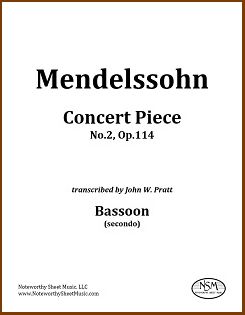 Concert Piece No.2, Op.114, by Felix Mendelssohn
Concert Piece No.2, Op.114, by Felix Mendelssohn
Transcribed for Various Wind Instruments (and piano) by John W. Pratt
(originally for Clarinet, Basset Horn, and Piano)
Primo parts for Clarinet, Flute, or Oboe, PDFs $5.99 each
Secondo parts for Bassoon, Clarinet, or English Horn, PDFs $5.99 each
Each wind part is 4 pages of music; 6 pages total.
Primo parts for Flute, Clarinet in B-flat (note that the original primo clarinet part is freely available on IMSLP.org), or Oboe.
Secondo parts for Clarinet in B-flat, Bassoon, or English Horn. Preview Bassoon II part
Mozart - Quintet, K.515, arr. Flute Quintet
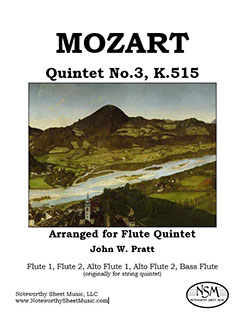 Quintet, K.515, by Wolfgang Amadeus Mozart
Quintet, K.515, by Wolfgang Amadeus Mozart
Arranged for Flute Quintet by John W. Pratt (originally for strings)
Score and Parts for Flute 1, Flute 2, Alto Flute 1, Alto Flute 2, and Bass Flute, PDF $26.50
Wolfgang Amadeus Mozart wrote six quintets for 2 violins, 2 violas, and cello. Two of these, K.515 in C major and K.516 in G minor, are generally regarded as high points in Mozart’s, and indeed all, chamber music. Performances of K.515 are infrequent, far less than such great music deserves, since there is not enough repertoire to support permanent string quintets and string quartets have an abundance of great music to play without needing to find an additional violist. Adaptation to flute quintet is thus particularly apropos, as its textural possibilities apply also to a flute quintet, and its musical and emotional content are well worth viewing through the prism of five flutes. Our edition includes a score as well as parts for two concert flutes, two alto flutes, and bass flute. (adapted from jwp’s foreword to the edition)
Score, 37 pages; Flute 1, 16 pages of music; Flute 2, 14 pages of music; Alto Flute 1, 16 pages of music; Alto Flute 2, 14 pages of music; and Bass Flute, 14 pages of music; Total, 124 pages.
PreviewMozart - Quintet, K.516 - arr. Flute Quintet
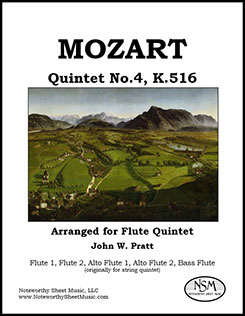 Quintet, K.516 by Wolfgang Amadeus Mozart
Quintet, K.516 by Wolfgang Amadeus Mozart
Arranged for Flute Quintet by John W. Pratt (originally for strings)
Score and Parts for Flute 1, Flute 2, Alto Flute 1, Alto Flute 2, and Bass Flute, PDF $23.50
Wolfgang Amadeus Mozart (1756-1791) wrote six quintets for 2 violins, 2 violas, and cello. Two of these, K.515 in C major and K.516 in G minor, are generally regarded as high points in Mozart’s, and indeed all, chamber music. Adaptation of K.516 to flute quintet is apropos, as its textural possibilities apply also to a flute quintet, and its musical and emotional content are well worth viewing through the prism of five flutes. In John Pratt’s arrangement, the work has been transposed up a step to better adapt to a flute ensemble. Our edition includes a score as well as parts for two concert flutes, two alto flutes, and bass flute.
Score, 30 pages; Flute 1, 14 pages; Flute 2, 13 pages; Alto Flute 1, 14 pages; Alto Flute 2, 13 pages; and Bass Flute, 11 pages of music; Total, 106 pages.
PreviewMozart - Sinfonia Concertante - Fl/Cl/Pf
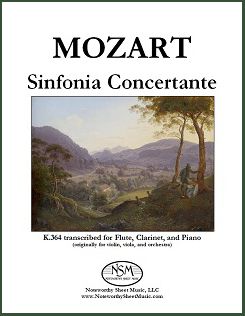 Sinfonia Concertante, K.364, by Wolfgang Amadeus Mozart
Sinfonia Concertante, K.364, by Wolfgang Amadeus Mozart
(originally for Violin, Viola, and Orchestra)
Piano Score, Flute & Clarinet Parts, PDF $17.99
Excerpted from the Foreword by J. W. Pratt: "The idea that every piece, especially a major one, can be satisfactorily transcribed for whatever instruments one would like is one I firmly reject. However, a trio arrangement of this Sinfonia Concertante for flute, clarinet, and piano can, I believe, capture and present in a new light many of the wonders of this great work, even the wonders of its sonorities. .... In the arrangement here, the flute and clarinet almost always play either a solo part or an orchestral part with only octave changes. .... For the piano, on the other hand, straightforward orchestral reduction is often ineffective and unsatisfying, and that would certainly be true here, even with the flute and clarinet taking some wind parts. I have attempted instead to find natural piano "orchestrations" as alternatives to Mozart's orchestral layouts, especially where the full orchestra is playing. .... Such effects, often heightened on returns, are better suited to the piano's capabilities and its role as a member of a trio than a straightforward reduction would be. .... The music available for flute, clarinet, and piano includes surprisingly few major works. The purpose of our arrangement is to add a significant piece to this repertoire and to enable players and listeners to enjoy Mozart's magnificent Sinfonia Concertante in a new way."
Score, 41 pages; Flute part, 18 pages; Clarinet part, 17 pages; Total, 82 pages.
Preview